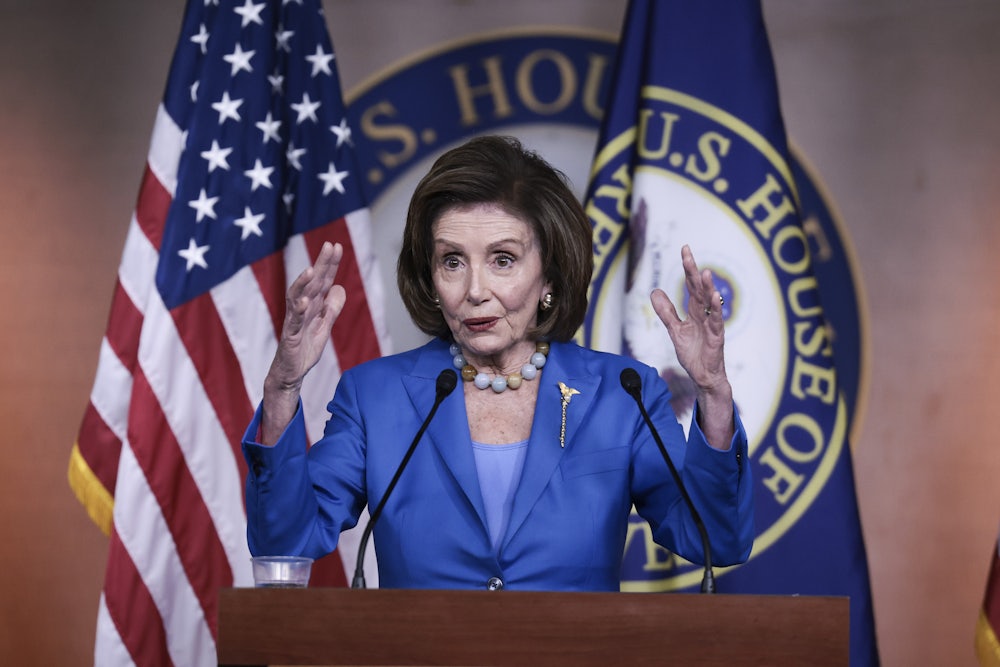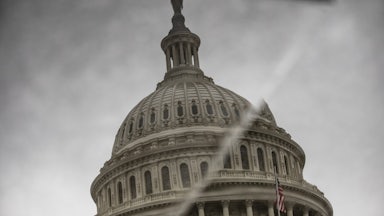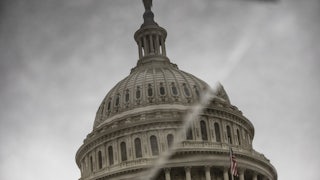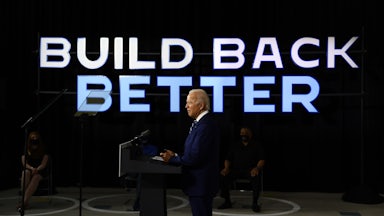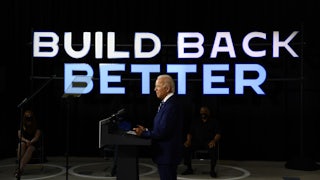Halfway through October, Democrats seem no closer to reaching an agreement on the massive social spending bill at the center of the Biden agenda than they did in September. Democratic leadership has insisted that a deal must be reached by the end of this month, but after last month’s abortive effort to hold a vote on a bipartisan infrastructure bill without a deal on the other measure, the party remains locked in a debate over what the final top line should be, and what programs among the many that were originally proposed should remain after the culling.
The bill will have to be approved through the complicated and arduous process of reconciliation, allowing it to pass with a simple majority of votes in the Senate. The debate over the reconciliation bill has exposed fault lines among Democrats along ideological lines, with moderates unwilling to condone a $3.5 trillion price tag and progressives adamant against cutting what they see as critical programs. Halloween is fast approaching, but the scariest dilemma haunting progressives right now is what, if anything, they would be willing to cut in order to slim down the bill.
A senior progressive strategist, who requested anonymity to speak candidly, said that Democrats should begin prioritizing what has to be included in the bill before reaching a certain cap. “They’re going to have to start by building [on] what’s nonnegotiable, and absolutely necessary, and see where that leaves them on a price tag,” the strategist said. “Then, I think, for some of the other programs, it really becomes about how much can you fit in under the ceiling.”
Part of the problem is in determining what the bill might actually accomplish. It touches upon a host of Democratic priorities, including childcare, education, affordable housing, health care, and climate change. Because the breadth of the bill is so immense—and because it’s still uncertain what final provisions will be included—it has become defined by its price tag rather than its contents.
“When you do a whole slew of things, 25 things, that’s amazing if you’re a policy person and you want to do a lot of stuff. But if you want to explain why you’re spending $3 trillion, it gets really hard,” said Matt Glassman, a senior fellow at the Government Affairs Institute at Georgetown University.
Democrats also have differing ideas about what is most important in the bill, Glassman said. For some, the ultimate price tag is the biggest issue; for others, the greatest sticking point will be how the bill will be paid for. (One condition of passing a bill through reconciliation is that it must be deficit-neutral.) Still others believe that what ends up being included in the bill is more important than how much the outlay is, or how its costs are offset.
This discrepancy in priorities is demonstrated in part by outstanding objections from Senators Joe Manchin and Kyrsten Sinema, both of whom have expressed opposition to a $3.5 trillion bill. Sinema has been more opaque in her goals than Manchin but reportedly has objections to one of the major proposed revenue streams for the bill, raising corporate taxes.
Manchin has not been explicit about what, exactly, he would like to cut from the bill; he has dropped some bread crumbs—and, in a few instances, some outright croutons—hinting at changes that would be amenable to him. The moderate Democrat from West Virginia has floated $1.5 trillion as a top line he would be able to support and suggested that some programs could benefit from means testing or having lower income thresholds for eligibility. He has also objected to the $150 billion “clean electricity performance program,” which would incentivize utility companies to increase their renewable energy supplies.
Democrats have a few options at their disposal for slimming down the bill, but ultimately, it will come down to prioritization: determining what is most important to include and what can, however reluctantly, be saved for future legislation.
One major point of contention is health care: Democrats may have to choose whether it is more important to strengthen the Affordable Care Act and expand Medicaid coverage or expand Medicare to cover vision, hearing, and dental care.
House Majority Whip Jim Clyburn is one of the biggest advocates for expanding Medicaid, which would provide coverage for the 2.2 million low-income Americans living in states that have not expanded Medicaid. Clyburn told The New Republic that, given the likely lower price tag required, he would argue that expanding coverage for poorer Americans should take precedence over a policy that would benefit the wealthiest along with everyone else. “I don’t have anything against expanding Medicare, except that there’s a finite amount of money. I think the emphasis should be on Medicaid,” Clyburn said.
Another complicating factor is having the revenue to offset these programs. It’s also possible that a provision to allow Medicare to negotiate drug prices, which has been met with skepticism by moderates, could be dropped from the bill. Speaker Nancy Pelosi said in an interview with KQED on Thursday that she is “not even sure we’ll get it in this bill.”
“We’ll get something of that, but it won’t be the complete package that many of us have been fighting for a long time,” Pelosi said. That policy would save several hundred billion dollars, which could be spent on other health care priorities. And Senator Bernie Sanders, a staunch advocate of expanding Medicare, told reporters on Tuesday that adding dental, hearing, and vision coverage was “not negotiable.”
This all feeds into what is yet another source of tension currently roiling Democrats: whether it’s better to implement many programs for a short period of time—with a cutoff date of, say, 2025—or administer a few programs for a longer period or even permanently. Thus far, Pelosi has toggled between the two options, telling Democrats in a letter on Monday that “overwhelmingly, the guidance I am receiving from members is to do fewer things well so that we can still have a transformative impact on families in the workplace and responsibly address the climate crisis.”
But on Tuesday, Pelosi said that Democrats would consider “cutting back on years” for some of the programs and that “timing would be reduced, in many cases, to make the cost lower.” Then, in the KQED interview on Thursday, the speaker argued that if a time frame is cut too far, “you lose the continuity and the impact.”
In a letter to Pelosi on Wednesday, members of the Congressional Progressive Caucus called this dichotomy a “false choice.” But they also argued in favor of making “shorter, transformative investments” and implementing programs that “touch people’s lives immediately.”
“If given a choice between legislating narrowly or broadly, we strongly encourage you to choose the latter and make robust investments over a shorter window,” the letter said.
This sentiment echoed remarks made by Progressive Caucus Chair Pramila Jayapal in a call with reporters on Tuesday. “We would reduce the number of years because the universality of benefits and the immediacy of benefits are absolutely critical. And that, frankly, is more important to us than having it for the entire 10 years,” Jayapal said.
But it’s possible that implementing programs for a shorter period of time could create a cliff wherein multiple benefits would abruptly expire. If Republicans are in control of the White House and one or both houses of Congress in 2025, what’s to stop them from just letting these programs lapse?
Ben Ritz, the director of the Center for Funding America’s Future at the Progressive Policy Institute, argues that Republicans could easily allow these programs to wither on the vine. He compared the current situation to the fight over the Affordable Care Act; Republicans were unsuccessful in repealing the bill in 2017, in part because they had no alternative. But if the ACA had a sunset date of 2017, he said, it’s easy to imagine Republicans just allowing it to end.
“I think that’s the biggest risk, that people will plan their lives around these programs, they’ll come to depend on the benefits, and then [the programs will] be yanked away,” Ritz told The New Republic. Ritz wrote a report published earlier this month making suggestions to trim the bill down to $2 trillion, including by shoring up the ACA and expanding Medicaid coverage. (Ritz’s framework also cautions against weakening or lifting the cap on the state and local tax deduction, a major priority for lawmakers in northeastern states with high property taxes. Opponents argue that it would primarily aid the very rich and therefore undermine the purpose of the reconciliation bill.)
Extending programs in the short term could amount to a high-risk, high-reward scenario—if a program like the expanded child tax credit becomes entrenched, benefiting voters of both parties, it would be far more difficult politically for Republicans to allow it to expire. Glassman compared the idea to tax cuts implemented under the Bush administration, which had a sunset date of 2013—but were largely reinstated under the Obama administration. Republicans made a similar gamble in 2017, when they implemented tax cuts set to expire in 2025. “It’s not simply easy to let something expire like that,” Glassman said.
Given that Republicans are structurally advantaged to retake Congress in the midterm elections, Democrats need to establish the programs they do choose to include so that they are noticed and appreciated by the American public. The strategist argued that Democrats should take action to “do the most to actually transform people’s lives” while they can, even if that requires short-term investments.
“I think there’s a lot of benefit in setting up these programs and forcing Republicans’ hands, but I think you’d want to make sure you set them up in a way that Americans are actually going to feel them, and actually ensure that they matter,” the strategist said.
Repealing benefits that have not yet gone into effect, however, is a horse of a different color. Adding Medicare benefits would be costly and difficult to roll out quickly; vision care could begin in 2022 and hearing in 2023, but dental care would not roll out until 2028. It’s not inconceivable that Republicans, upon retaking Congress, could overturn the expansion. The idea is also being met with skepticism from some Democrats; Representative Jared Golden argued in a letter that the current plan for Medicare expansion was an “underdeveloped proposal” and worried about “budget gimmicks” that masked its true cost.
This is another problem with sunsetting certain programs after a few years. The bill may set up programs to expire five years from now, but they are really intended to be permanent—meaning that this would only cut costs superficially. “If you just pretend this stuff’s gonna expire, then you save money, but you don’t really because no one’s ever going to cut this stuff,” Glassman said.
Progressives have also argued that cutting down the bill amounts to pitting different groups against each other: choosing between the elderly or low-income Americans, for example, or between providing affordable housing or universal pre-kindergarten. There may already be consequences for cutting down the bill from its initial $3.5 trillion top line; an October report by the Economic Policy Institute, a left-leaning think tank, found that cutting the bill to $1.5 trillion would create two million fewer jobs. Advocates also argue that, given disappointing jobs numbers and a mass exodus of women from the workforce, programs such as paid leave and childcare would be critical for stimulating the economy.
“There is a real risk that if this proposal gets whittled down too much, it will be a proposal that doesn’t meet the moment,” said Lindsay Owens, an economist and the executive director of the Groundwork Collaborative, an organization that advocates for progressive economic policies. “This isn’t an academic debate. Choosing between housing and caregiving is really a false choice … we can afford to do both.”
Ultimately, Democrats may have to confront a political reality: They can’t pass the reconciliation bill if two Democratic senators oppose it, and that may mean hard choices.
“I think budgeting is always about trade-offs … you have to make a decision somewhere. Is it really having any fewer trade-offs to say we’re only going to a temporary child tax credit, or we’re going to cut the child tax credit to make room for Medicare expansion?” Ritz argued. “It’s better to just ask ourselves straight: What are the most important needs for our society?”
